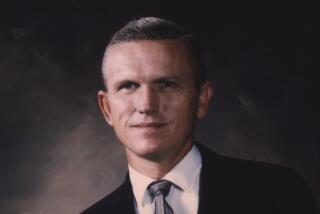Earth’s First Moon Visitors Push Similar Trip to Mars
- Share via
BOULDER, Colo. — The first humans to reach the moon marked the 18th anniversary of that achievement here Monday with an impassioned plea for an American mission to Mars.
“Space is where the future is,” said Edwin E. Aldrin Jr., who followed Neil Armstrong in taking the first steps on the moon in 1969. He urged the United States to set its goals on Mars, as has the Soviet Union.
Joining Aldrin in that exhortation at a conference on Mars here was Michael Collins, who had remained in the command module while Aldrin and Armstrong descended to the moon’s surface. Armstrong could not attend the conference, Aldrin said, but the three agreed to issue a joint statement declaring their support for a mission to Mars.
It had taken 10 years for the nation to prepare for the journey to the moon, “but we got there, and we’ll go to Mars and beyond,” Aldrin told several hundred scientists attending the Case for Mars conference at the University of Colorado.
“America needs the space program because of the lift it gives men’s souls,” he said.
The conference began several years ago as a grass-roots movement among students at the University of Colorado and advocates of a Mars mission. The conference this year--the third in the history of the movement--is being sponsored by the National Aeronautics and Space Administration, the Planetary Society and several other organizations.
‘Define the Mission’
James E. Fletcher, NASA’s administrator, told the conference that he embraces the goal of exploring Mars, but he stopped considerably short of saying how high a priority Mars has in his agenda as head of the space agency.
“I firmly believe we should go, and I’m confident we will go, but the question is when will we be ready?” Fletcher said. “We must begin now to define the mission.”
And even if planning began this year, a manned mission to Mars could not be attempted before the year 2003, he said.
“It is not likely that we would send a manned Mars mission on its way until after the return of a Mars (surface) sample provided by a robot spacecraft so that we could test Martian soil for potentially harmful or deadly organisms,” Fletcher said.
“Even if we were to start extensive preliminary studies for such a mission right away, we could not launch before 1998 or have a sample before 2001. That means a manned Mars mission with assurance of biological safety could not be ready for departure until after the turn of the century.”
More to Read
Sign up for Essential California
The most important California stories and recommendations in your inbox every morning.
You may occasionally receive promotional content from the Los Angeles Times.












